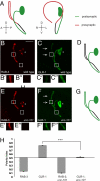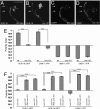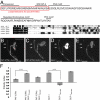Clathrin adaptor AP-1 complex excludes multiple postsynaptic receptors from axons in C. elegans
- PMID: 19164532
- PMCID: PMC2635768
- DOI: 10.1073/pnas.0812078106
Clathrin adaptor AP-1 complex excludes multiple postsynaptic receptors from axons in C. elegans
Abstract
Neurons are highly polarized cells with morphologically and molecularly distinct axonal and dendritic compartments. It is not well understood how postsynaptic receptors are selectively enriched in dendrites in vivo. We investigated the molecular mechanisms of dendritically polarized localization of a glutamate receptor, an acetylcholine receptor, and a ROR-type receptor tyrosine kinase in the interneuron RIA in C. elegans. We found that the clathrin adaptor AP-1 complex mu1 subunit UNC-101 functions cell autonomously to maintain the correct localization of these receptors in a dynamin-dependent manner. In unc-101 mutants, instead of being dendritically enriched, all 3 receptors are evenly distributed in the axonal and dendritic compartments. Surprisingly, UNC-101 predominantly localizes to the axonal compartment, suggesting a possible transcytosis model for the dendritic targeting of neurotransmitter receptors.
Conflict of interest statement
The authors declare no conflict of interest.
Figures





Similar articles
-
LRK-1, a C. elegans PARK8-related kinase, regulates axonal-dendritic polarity of SV proteins.Curr Biol. 2007 Apr 3;17(7):592-8. doi: 10.1016/j.cub.2007.01.074. Epub 2007 Mar 8. Curr Biol. 2007. PMID: 17346966
-
Distinct and redundant functions of mu1 medium chains of the AP-1 clathrin-associated protein complex in the nematode Caenorhabditis elegans.Mol Biol Cell. 2000 Aug;11(8):2743-56. doi: 10.1091/mbc.11.8.2743. Mol Biol Cell. 2000. PMID: 10930467 Free PMC article.
-
Polarized dendritic transport and the AP-1 mu1 clathrin adaptor UNC-101 localize odorant receptors to olfactory cilia.Neuron. 2001 Aug 2;31(2):277-87. doi: 10.1016/s0896-6273(01)00361-0. Neuron. 2001. PMID: 11502258
-
Cyclin-dependent kinase 5 regulates the polarized trafficking of neuropeptide-containing dense-core vesicles in Caenorhabditis elegans motor neurons.J Neurosci. 2012 Jun 13;32(24):8158-72. doi: 10.1523/JNEUROSCI.0251-12.2012. J Neurosci. 2012. PMID: 22699897 Free PMC article.
-
Localization mechanisms of the axon guidance molecule UNC-6/Netrin and its receptors, UNC-5 and UNC-40, in Caenorhabditis elegans.Dev Growth Differ. 2012 Apr;54(3):390-7. doi: 10.1111/j.1440-169X.2012.01349.x. Dev Growth Differ. 2012. PMID: 22524608 Review.
Cited by
-
Structures of highly flexible intracellular domain of human α7 nicotinic acetylcholine receptor.Nat Commun. 2022 Feb 10;13(1):793. doi: 10.1038/s41467-022-28400-x. Nat Commun. 2022. PMID: 35145092 Free PMC article.
-
UNC-6 and UNC-40 promote dendritic growth through PAR-4 in Caenorhabditis elegans neurons.Nat Neurosci. 2011 Feb;14(2):165-72. doi: 10.1038/nn.2717. Epub 2010 Dec 26. Nat Neurosci. 2011. PMID: 21186357 Free PMC article.
-
Presynaptic autophagy is coupled to the synaptic vesicle cycle via ATG-9.Neuron. 2022 Mar 2;110(5):824-840.e10. doi: 10.1016/j.neuron.2021.12.031. Epub 2022 Jan 21. Neuron. 2022. PMID: 35065714 Free PMC article.
-
Forgetting generates a novel state that is reactivatable.Sci Adv. 2022 Feb 11;8(6):eabi9071. doi: 10.1126/sciadv.abi9071. Epub 2022 Feb 11. Sci Adv. 2022. PMID: 35148188 Free PMC article.
-
Cargo recognition in clathrin-mediated endocytosis.Cold Spring Harb Perspect Biol. 2013 Nov 1;5(11):a016790. doi: 10.1101/cshperspect.a016790. Cold Spring Harb Perspect Biol. 2013. PMID: 24186068 Free PMC article. Review.
References
-
- Horton AC, Ehlers MD. Neuronal polarity and trafficking. Neuron. 2003;40:277–295. - PubMed
-
- Winckler B, Mellman I. Neuronal polarity: Controlling the sorting and diffusion of membrane components. Neuron. 1999;23:637–640. - PubMed
-
- Burack MA, Silverman MA, Banker G. The role of selective transport in neuronal protein sorting. Neuron. 2000;26:465–472. - PubMed
Publication types
MeSH terms
Substances
Grants and funding
LinkOut - more resources
Full Text Sources
Other Literature Sources

